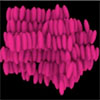| Oct 04, 2021 |
|
(Nanowerk News) Most of our daily commodities, such as plastics, alloys and processed foods, are provided as solids, and they are often processed by a controlled cooling process from a liquid mixture to a solid. Liquid crystals, solutions, polymers, and biomaterials form a wide variety of structural patterns arising from differences in the cooling processes. These patterns provide a diversity of functions, and can significantly influence the properties of solid products.
|
|
For this reason, understanding how the cooling process proceeds and how it can be controlled is important in diverse research fields such as physics, biology, materials science, and engineering.
|
|
In many cases, the formation of a solid in a cooling process is initiated with the formation of nanostructures, for which the classical nucleation theory (CNT) has given a simple explanation.
|
|
However, CNT cannot quantitatively account for some important physical properties such as the rate of nanostructure formation. Molecular simulations are promising means as a technology enabling the observation of microscopic movement of individual molecules, to count the number of nanostructures, and quantify how they increase.
|
|
However, there are many kinds of nanostructures that are difficult to observe using molecular simulations alone, and combinations of molecular simulations with other advanced technologies are being envisaged to overcome this difficulty.
|
|
For example, the existence of characteristic nanostructures in liquid crystals during the cooling process has been predicted based on X-ray scattering experiments.However, the details of such nanostructures could not be revealed by molecular simulations alone and have remained an open question.
|
|
It has thus been highly desired to develop computational technologies that provide new analysis methods for the identification of nanostructures with high accuracy, facilitating the design of innovative materials.
|
|
One of the goals of the “Ultra High-Throughput Design and Prototyping Technology for Ultra Advanced Materials Development Project” of the New Energy and Industrial Technology Development Organization (NEDO) is to accelerate the development of organic and polymeric functional materials through the trinity of computational science, process technology, and measurement technology.
|
|
As a part of this Project, Dr. Kazuaki Z. Takahashi, Senior Researcher of the Research Center for Computational Design of Advanced Functional Materials (CD-FMat), National Institute of Advanced Industrial Science and Technology (AIST), Dr. Takeshi Aoyagi, Principal Research Manager of CD-FMat, AIST, and Dr. Jun-ichi Fukuda, Professor of Department of Physics, Faculty of Science, Kyushu University, have been developing the technologies aiming at the control of material structures, paying particular attention to nanostructuring as a starting point.
|
|
Their study (Nature Communications, “Multistep nucleation of anisotropic molecules”) focuses on the cooling process of liquid crystals, typical organic and polymeric functional materials.
|
|
They have developed a novel analysis method that combines molecular simulation and artificial intelligence (AI) to observe the process of the formation of characteristic nanostructures in quenched liquid crystals. They discovered a three-step process of nanostructuring that cannot be explained by classical nucleation theory, and also clarified its mechanism.
|

